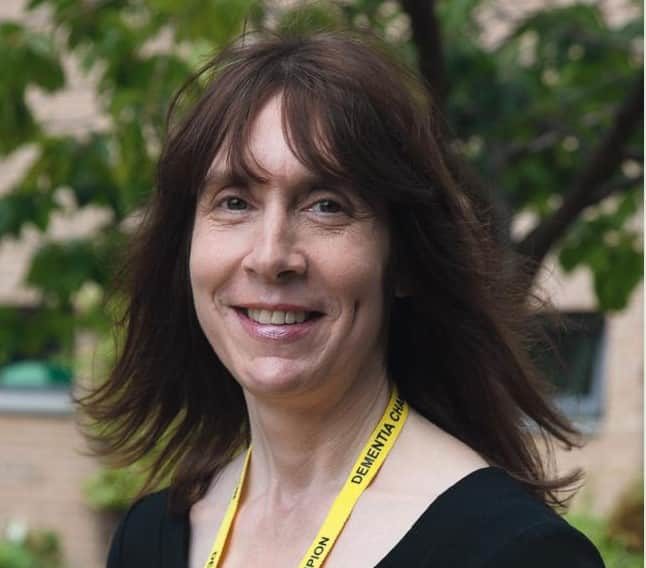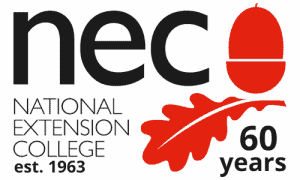Call free on: 0800 389 2839
Call free on: 0800 389 2839
Join in... The latest news and blogs from NEC
Finding the motivation to study Monday, 14 December 2020

Anna Ellis completed A level Religious Studies with NEC this month and is currently studying with the Open University. She has qualifications in teaching and nursing and is a student mentor for NEC. Read on to learn more about her experience studying with NEC and finding the motivation to study through tough times.
Sorting it out and getting it done – how I (finally) completed my A level course!
In my last blog (which can be read here) I wrote about the difficulties of getting past assignment one. We’ve all been through a lot since then, none of which could have been imagined eleven months ago. But on the first of November 2020, I submitted my final assignment to my tutor with a mixture of emotions – relief, delight, but also regret that the course was finished. What I felt most of all, though, was a tremendous sense of achievement. I had achieved what had seemed, ten months before, almost impossible.
For distance learners, course completion is not easily accomplished. The biggest hurdles, research shows, are the early assignments. Enthusiasm and motivation run out far too quickly, even if they had seemed strong. The task can seem overwhelming when the learner hasn’t yet gained sufficient knowledge to start to understand the bigger picture. Linking facts and arguments together, beginning to make comparisons, evaluations and analysis – it all happens as you progress. It’s difficult to imagine at the beginning.
I think embarking on a new course might be usefully compared to a particularly difficult 1000-piece jigsaw. An old-fashioned type of puzzle, you might think, but a useful analogy. Imagine that the small pieces of our imaginary jigsaw puzzle are tipped haphazardly from their box onto a board in front of you. To expand the comparison, we can liken these to the contents of the course syllabus. It’s all there, but as it’s not been seen before it all seems a lot of jumble. Fortunately, there’s a large full colour picture to refer to, depicting an attractive scene. Think of that as the course materials. Those who decide to make a start on the puzzle will, probably, find the straight edges and put them together. That’s an introductory assignment done, not too difficult. To continue the puzzle most will try building up from one edge, turning and sorting the pieces. It is entirely possible that until a certain point is reached – that is, until some parts of the image are put together – it all seems annoying, strange and overwhelming.
My point is this. Studying a new subject, without some systems in place, is very difficult. When working on my first two assignments, I tried to get on by reading the course materials, watching a few videos, tackling the questions. It all seemed to make sense while I was getting on, but I quickly forgot what I’d read. When I grasped the amount of content that was necessarily going to be covered, none of which was sticking in my head, I gave up. And I had only got the first assignment done.
How to find the motivation to study
Something told me that was a shame; a wasted opportunity, something I’d come to regret. So, ten months later, I went back to the course with a more focused approach. I soon recognised that I needed to get organised. Going back (for the last time) to that jigsaw, we know that it makes life easier for puzzlers to collect colours in one pile, patterns in another, shapes in a third. Then to select one pile and sort it further: colours into shades, perhaps. It also pays to study – really study, not just glance at – the picture so you can understand what fits where, and how that fits in relation to everything else. A jigsaw gets easier as you build it up and it seems easy by the end. People who enjoy jigsaws and do them frequently find they can complete them more swiftly and improve their memory, problem solving and spatial reasoning skills.
 Of course, studying is different in some key aspects. A course gets more challenging in terms of content, but it is easier in the sense that you are building your understanding. When I re-started my course, I created a study plan, a system for note taking, and a filing system so I could refer to key points and remind myself of them. I used sticky notes and I bought some new coloured fine liner pens to make diagrams and images, because I enjoy that sort of thing. All these – and more – can be done on a computer or tablet instead of on paper and card. The point is, I was building something of my own making that I could refer to as I went along. None of it was pretty, but I knew I could understand what I’d written in my own notes.
Of course, studying is different in some key aspects. A course gets more challenging in terms of content, but it is easier in the sense that you are building your understanding. When I re-started my course, I created a study plan, a system for note taking, and a filing system so I could refer to key points and remind myself of them. I used sticky notes and I bought some new coloured fine liner pens to make diagrams and images, because I enjoy that sort of thing. All these – and more – can be done on a computer or tablet instead of on paper and card. The point is, I was building something of my own making that I could refer to as I went along. None of it was pretty, but I knew I could understand what I’d written in my own notes.
Once past assignment three I started to see the connections in the different parts of the course. My assignments were a lot of work, but it was worth it when I got them back with my tutor’s comments. As the course went on, I learned to pay particular attention to the question and exactly what it was asking for. ‘Explore’ remained my favourite option, but if it asked for evaluation or analysis, I learned to make my own decisions with growing confidence.
Exam questions in arts subjects are sometimes designed so that different but equally valid conclusions may be drawn. I stopped wavering between one opinion and another in an essay. I learned to structure the essay, to make choices and defend them, while acknowledging the validity of another point of view.
We learn to understand a subject by engaging with it. A useful quote, attributed to Picasso, notes that ‘inspiration exists, but it has to find you working’. A course starts with hard work and ends with hard work, and is hard work all the way through. Yet it is also exciting, life-changing, mind-expandingly brilliant. At least, that’s how it seems to me.
Look out for Anna’s forthcoming blogs on:
- Preparing for exams
- Mentoring
- Motivation and getting started
Leave a Reply Cancel reply
More stories
working at NEC
Uncategorized
- Balancing an A level with My Passion for Dance
- The Future of Art History: Why Study A level History of Art with the National Extension College?
- Why Study Physics?
- Embracing a New Path: Jill’s Journey from Online Learning to Career Success in Art History
- How Toby Found a Perfect Fit for His Passion: Online A level English Literature with NEC
Study Tips
Student Stories
- Balancing an A level with My Passion for Dance
- Passion and Academics: How Izzy Balances Full-time Musical Theatre Studies with Studying A level Physics
- How NEC Helped Kari’s Son Niko to Continue his A level Studies Despite Long-Term Illness
- Embracing a New Path: Jill’s Journey from Online Learning to Career Success in Art History
- How Toby Found a Perfect Fit for His Passion: Online A level English Literature with NEC
SFT
Results Day
- Resitting A level STEM Subjects: How to Turn Your Setback into a Stepping Stone for a Brighter Future
- Resits vs. Retakes: Understanding the Difference and Making the Most of Your Second Chance
- GCSE Results Day 2024: What to Do When You Didn’t Get the GCSE Results You Wanted
- GCSE Results Day 2024: Your Complete Guide
- A level Results Day 2024: Your Ultimate Guide to Success
Policy and Campaigns
- A Pathway to Success Beyond A levels: Why Level 4 and Level 5 Qualifications Matter
- Schools and Academies Show 2024: Insights for School Leaders
- Big Data and Educational Trends: Insights for Students and Schools
- University of Cambridge Institute of Continuing Education offers tuition fee bursary for NEC A level students
- Five study bursaries for state sector teachers to take online A level Classical Civilisation offered by The Classical Association
Podcast
Our Courses
- Balancing an A level with My Passion for Dance
- How NEC’s Inclusive Approach to Learning Design is Redefining Independent Learning
- NEC’s Learning Design: A Pathway to Success for Independent Learners
- Passion and Academics: How Izzy Balances Full-time Musical Theatre Studies with Studying A level Physics
- Why Study Psychology? – Key Benefits, Careers and What You’ll Need to Study Psychology at University
Lifelong Learning
- A Pathway to Success Beyond A levels: Why Level 4 and Level 5 Qualifications Matter
- Benefits of Homeschooling: Is Home Education Right for Your Family?
- How NEC’s Inclusive Approach to Learning Design is Redefining Independent Learning
- The Future of Art History: Why Study A level History of Art with the National Extension College?
- National Coding Week 2024: The Vital Role of Coding in the Modern World
Home Schooling
- Benefits of Homeschooling: Is Home Education Right for Your Family?
- How NEC Helped Kari’s Son Niko to Continue his A level Studies Despite Long-Term Illness
- Exploring Science Practicals at Home: A Guide for Homeschoolers
- Homeschooling in 2024: How to Personalise Your Child’s Education
- What is Homeschooling?
Guest Blogs
- Passion and Academics: How Izzy Balances Full-time Musical Theatre Studies with Studying A level Physics
- My Experience as a Marketing Intern with the National Extension College
- The economics of political parties
- Embarking on a journey: My decision to ‘Fast-Track’ A level Physics with NEC
- Homeschooler Andrew’s experience of studying IGCSE Chemistry
General
- Balancing an A level with My Passion for Dance
- A Pathway to Success Beyond A levels: Why Level 4 and Level 5 Qualifications Matter
- Schools and Academies Show 2024: Insights for School Leaders
- How NEC’s Inclusive Approach to Learning Design is Redefining Independent Learning
- NEC’s Learning Design: A Pathway to Success for Independent Learners

Add a new comment
Current comments: 0